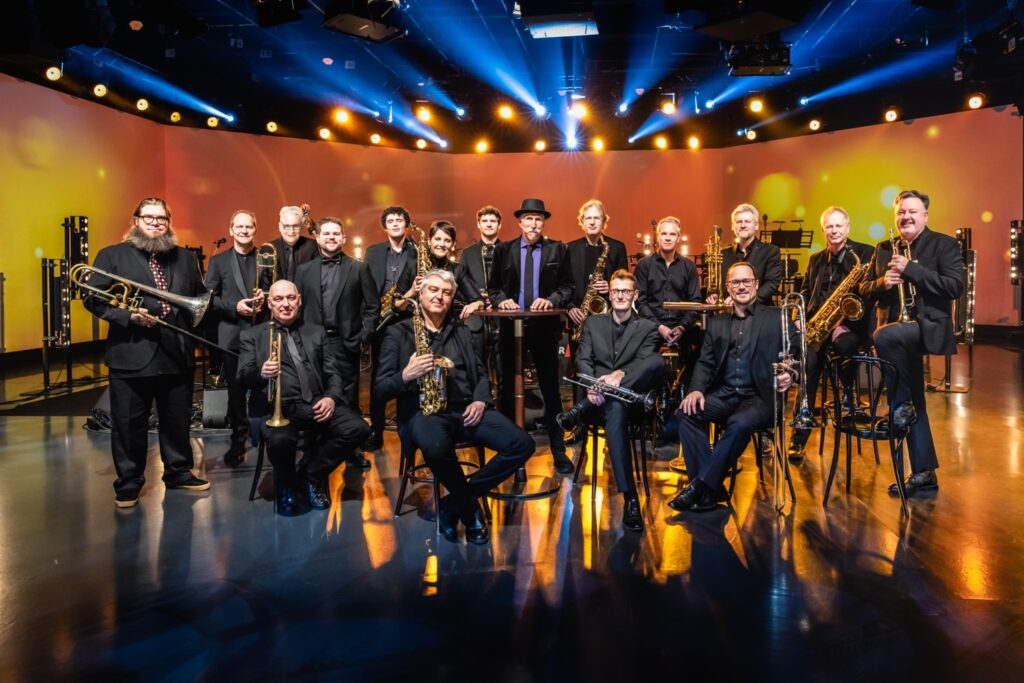With Bob Mintzer Directing, the WDR Big Band Returns to America for First Time in 19 Years
The WDR’s new album with Mintzer, a contemporary jazz giant from New York, is titled ‘Bluegrass’ and is an especially American project in its very nature.

WDR Big Band
Directed by Bob Mintzer
‘Bluegrass’
MCG Jazz
Early in the first set of a two-night/four-show run at Birdland by the WDR Big Band, its musical director, Bob Mintzer, gave the capacity crowd a brief bit of background on the ensemble we were hearing Tuesday night.
He informed us that this rather formidable orchestra — 17 regular members, and usually working with two or three additional guest stars — owes its existence to German public broadcasting. Based at Cologne, the WDR is one of a number of full-time jazz orchestras now working in Europe that are essentially subsidized by the local government and affiliated with radio and TV networks.
Mr. Mintzer added that the WDR Big Band hasn’t played America in 19 years, so these four shows were not to be missed — which helps explain why the room was so packed.
Like the Amsterdam-based Metropol Orkest, the WDR was founded in the early post-World War II years and has existed in some form ever since. The ensemble has collaborated effectively with composers-arrangers-bandleaders from both Europe and America, including a bass legend, Ron Carter, and a Vienna-born keyboard superstar, the late Joe Zawinal. (A year ago they gave a concert of the music of Miles Davis, newly arranged and conducted by an outstanding pianist from New Zealand, Alan Broadbent, which is viewable here.)
The WDR’s new album is not only their latest with Mr. Mintzer, a contemporary jazz giant from New York, but is an especially American project in its very nature. Titled “Bluegrass,” the new set co-stars two major players in that genre, mandolinist Mike Marshall and violinist Darol Anger.

Because the album is being released at the same moment as the WDR is appearing at Birdland, I assumed that this was what we call a “launch” event, in which they would feature music from the new album. Instead, Mr. Mintzer offered a panoply of works from other recent releases. With their special guest star, guitarist Dave Stryker, the WDR offered selections from the 2019 “Blue Soul,” including “Aha” and “Blue Strut,” the latter featuring Mr. Stryker playing long runs of octave-driven lines.
It was difficult to be disappointed, as Messrs. Mintzer and Stryker offered an exciting 90-minute set that fully justified putting up with the standing-room-only situation.
The evening began and ended with two ecstatically-swinging “I Got Rhythm” contrafacts, “Herky Jerky” (from the 2019 “Soundscapes”) and the provocatively titled “Runferyerlife,” which Mr. Mintzer introduced in another of his musical roles, as a member of the Yellowjackets, on their 2001 album “Mint Jam.”
Listening to the “Bluegrass” album is, in one sense, a game-changer: I will never, ever again refer to this American musical genre — closely connected to both the blues and country & western music — as “roots music.” One listen is enough to convince me that bluegrass is remarkably sophisticated, much like the blues and even jazz itself, and requires the same level of virtuosity.
Virtuosity is offered at every level of the WDR “Bluegrass” album. Mr. Mintzer’s arrangements — a combination of works by Messrs. Marshall and Anger and himself, as well as traditional tunes — are uncompromisingly modern jazz, yet they seamlessly integrate the two guest soloists as well as the top-drawer soloists in the big band itself.
The orchestrations often resemble aural portraits of rustic landscapes, of postmodern Appalachian springs and rodeos that suggest a mashup of Aaron Copland in his Americana phase with Dizzy Gillespie or Stan Kenton. As Mr. Marshall picks his mandolin like crazy over the dissonant background of brass and reeds, it could be a post nuclear hoedown.
“Emy In the Woods” is Mr. Mintzer’s expansion of a piece recorded by Messrs. Anger and Marshall on their 2019 release, “The Duo: Da Capo.” It’s listed as a traditional tune, but in this treatment it sounds like anything but. The first chorus — starting with the reeds and brass sans rhythm — kind of turns in on itself in something like a square dance rhythm, accentuated by Mr. Anger’s hot fiddle. This is truly the dosey-doe of the gods.
Trombonist Andy Hunter then takes “Emy” to a whole other place, and it gets even further out when Mr. Mintzer enters playing his electronic wind instrument. This oddball horn — which is also part of the arsenal of the 100-year-old sax master Marshall Allen — has a unique sound totally different from any other reed or brass instrument; it’s more like a keyboard or guitar synthesizer.
In much the same way, the WDR’s “Bluegrass” album doesn’t sound like anything else I’ve ever heard in the fields of jazz, country music, or Americana. Here’s hoping that the conductor and the orchestra return to Birdland sometime soon so that they can play this music live with Messrs. Marshall and Anger. I sure hope I don’t have to wait another 19 years to hear it.

